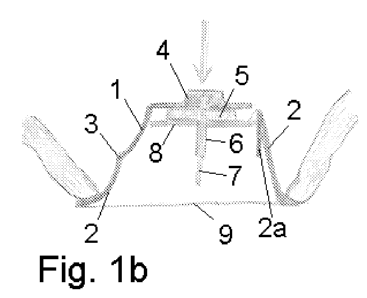Note: Claims are shown in the official language in which they were submitted.
Claims
1. Inserter device used to introduce an insertion needle (7, 17) when placing
a medical device sub- or transcutaneously, which inserter comprises a
housing (1, 2, 12) which hides the insertion needle (7, 17) before insertion
and can hide the insertion needle (7, 17) after insertion and placing of the
medical device, and where the insertion needle (7, 17) moves relative to the
housing (1, 2, 12) toward the patients skin surface during insertion
characterized in that the inserter device comprises a bi-stable elastic
element (1, 11) having two equilibrium states.
2. Inserter device according to claim 1, characterized in that one equilibrium
state is in a retracted position where the insertion needle (7, 17) and/or the
cannula (6, 16) is protected from the surroundings and the second
equilibrium state is in a forward position where the insertion needle (7, 17)
and/or the cannula (6, 16) extends from the housing (2, 12).
3. Inserter device according to claim 1 or 2, characterized in that the
insertion needle (7, 17) is secured to the elastic element (1, 11).
4. Inserter device according to claims 1, 2 or 3, characterized in that the
elastic element (1) is a part of the outer surface of the housing of the
inserter
device.
5. Inserter device according to claims 1, 2 or 3, characterized in that the
elastic element (1, 11) is constituted of a flexible piece of material having
two
opposite ends which ends are held stationary relative to the house at a
distance shorter than the length of the elastic element in a stretched or
unloaded state.
11
6. Inserter device according to any preceding claim, characterized in that
the elastic element (1) can be brought from one position to the other position
by activating means (23).
7. Inserter according to any of the preceding claims, characterized in that
the inserter device is disposable i.e. the inserter device is for single-use.
8. Inserter according to any of the preceding claims, characterized in that
the medical device to be inserted is an infusion part comprising a through
going opening and a cannula.
9. Inserter according to any of the claims 1-7, characterized in that the
device to be inserted is a sensor part comprising a sensor for sub- or
transcutaneous positioning.
10. Inserter according to any of the preceding claims, characterized in that
the medical device comprises an adhesive proximal surface for fastening of
the medical device to the skin of the patient.
11. Inserter according to any of the preceding claims, characterized in that
the medical device is provided with a hard self-penetrating cannula.
12. Inserter according to any of the claims 1-10, characterized in that the
inserter device is provided with a penetrating insertion needle (7, 17) and
the
medical device is provided with a soft cannula (6, 16).
